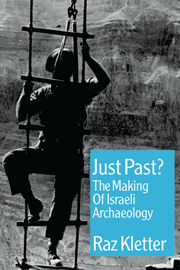Book contents
- Frontmatter
- Dedication
- Contents
- List of illustrations
- Introduction
- Acknowledgements
- Abbreviations
- 1 Archaeology and the 1948 War
- 2 Abandoned places, new places
- 3 Foreign aid
- 4 Frozen funds
- 5 A battalion of guards
- 6 Relief work
- 7 Man robs his land: “agreement” with General Dayan
- 8 “Gold of Ophir for Beth-Horon”: 3,000 shekels
- 9 The building beyond the border: the PAM, 1948–67
- 10 A building of dreams: a home for the IDAM and the origins of the Israel Museum, Jerusalem
- 11 A dead man on the council: the story of the supreme archaeological body in Israel
- 12 “But trust comes from the heart”: travels with the Government Tourist Corporation
- 13 “Whether in a courtyard of a synagogue, in a courtyard adjacent to a synagogue, or under a synagogue”: the Safad affair
- 14 The policy of salvage and early Israeli excavations
- 15 Myths and conclusions
- Appendix: other documents from the IDAM files
- Bibliography
- Author index
- Index
15 - Myths and conclusions
- Frontmatter
- Dedication
- Contents
- List of illustrations
- Introduction
- Acknowledgements
- Abbreviations
- 1 Archaeology and the 1948 War
- 2 Abandoned places, new places
- 3 Foreign aid
- 4 Frozen funds
- 5 A battalion of guards
- 6 Relief work
- 7 Man robs his land: “agreement” with General Dayan
- 8 “Gold of Ophir for Beth-Horon”: 3,000 shekels
- 9 The building beyond the border: the PAM, 1948–67
- 10 A building of dreams: a home for the IDAM and the origins of the Israel Museum, Jerusalem
- 11 A dead man on the council: the story of the supreme archaeological body in Israel
- 12 “But trust comes from the heart”: travels with the Government Tourist Corporation
- 13 “Whether in a courtyard of a synagogue, in a courtyard adjacent to a synagogue, or under a synagogue”: the Safad affair
- 14 The policy of salvage and early Israeli excavations
- 15 Myths and conclusions
- Appendix: other documents from the IDAM files
- Bibliography
- Author index
- Index
Summary
It is good to learn from the archaeologists the humility of Historical Perspective
Minister M. Ben-Tov, speech to the IES 5th Annual Conference (BIES 15 (1948/49): 48)THE GROWTH OF EARLY ISRAELI ARCHAEOLOGY
In the preceding chapters we have traced the history of early Israeli archaeology (for this term see Rosen, in press) and its many failures and successes. I wish to review its growth here and touch briefly on its role in the framework of nation building. Documents from the state archive naturally stress the IDAM, so conclusions regarding other bodies are limited.
We have seen how plans for a general survey failed completely for lack of budget (Ch. 2). Only some limited surveys were carried out, such as by Anati and Glueck in the Negev (Yeivin 1955b: 17–18) (Fig. 34), Aharoni in the Galilee (Alon 5–6 (1957): 45–9; BIES 19 (1954/55): 136–7; Aharoni 1956; Yeivin 1960: 47–9) and in Nahal Hever. The Judean Desert survey of 1960–61 was mainly aimed at finding scrolls (Bar-Adon 1980; Yadin 1963). The 1950s also saw the start of small-scale surveys before development (e.g. GL44883/12, 4.12.58).
We have noted the shortage of professional archaeologists (see pp. 126, 249, 303; Alon 2 (1950): 3; 5–6 (1957): 2; Mazar 1952: 18). The IDAM started with 11 workers (Yeivin 1955b: 3, 1960: 1; Alon 1 (1949): 24). By 1951 there were 39 (Alon 3 (1951): 64), and from 1952 about 50–55 regular workers (including guards; Yeivin 1960: 1; GL44868/7 no. 7652). By 1973 there were 86 regular workers.
- Type
- Chapter
- Information
- Just Past?The Making of Israeli Archaeology, pp. 310 - 320Publisher: Acumen PublishingPrint publication year: 2006



